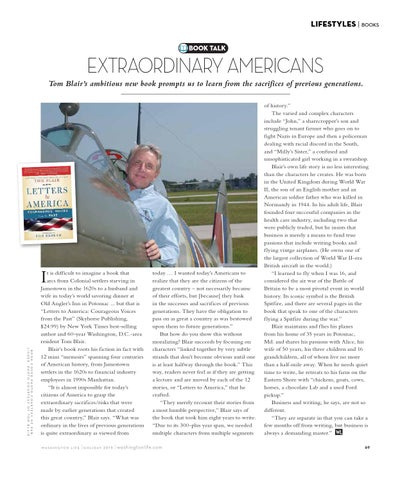LIFESTYLES | BOOKS BOOK TALK
EXTRAORDINARY AMERICANS Tom Blair’s ambitious new book prompts us to learn from the sacrifices of previous generations.
I
BO O K COV E R P H OTO CO U RT E SY O F P UB L I S H E R , P H OTO CO U RT E SY O F TO M B L AI R
t is difficult to imagine a book that arcs from Colonial settlers starving in Jamestown in the 1620s to a husband and wife in today’s world savoring dinner at Old Angler’s Inn in Potomac ... but that is “Letters to America: Courageous Voices from the Past” (Skyhorse Publishing, $24.99) by New York Times best-selling author and 60-year Washington, D.C.-area resident Tom Blair. Blair’s book roots his fiction in fact with 12 mini “memoirs” spanning four centuries of American history, from Jamestown settlers in the 1620s to financial industry employees in 1990s Manhattan. “It is almost impossible for today’s citizens of America to grasp the extraordinary sacrifices/risks that were made by earlier generations that created this great country,” Blair says. “What was ordinary in the lives of previous generations is quite extraordinary as viewed from WA S H I N G T O N L I F E
today … I wanted today’s Americans to realize that they are the citizens of the greatest country – not necessarily because of their efforts, but [because] they bask in the successes and sacrifices of previous generations. They have the obligation to pass on as great a country as was bestowed upon them to future generations.” But how do you show this without moralizing? Blair succeeds by focusing on characters “linked together by very subtle strands that don’t become obvious until one is at least halfway through the book.” This way, readers never feel as if they are getting a lecture and are moved by each of the 12 stories, or “Letters to America,” that he crafted. “They merely recount their stories from a most humble perspective,” Blair says of the book that took him eight years to write. “Due to its 300-plus year span, we needed multiple characters from multiple segments
| H O L I D AY | washingtonlife.com
of history.” The varied and complex characters include “John,” a sharecropper’s son and struggling tenant farmer who goes on to fight Nazis in Europe and then a policeman dealing with racial discord in the South, and “Milly’s Sister,” a confused and unsophisticated girl working in a sweatshop. Blair’s own life story is no less interesting than the characters he creates. He was born in the United Kingdom during World War II, the son of an English mother and an American soldier father who was killed in Normandy in 1944. In his adult life, Blair founded four successful companies in the health care industry, including two that were publicly traded, but he insists that business is merely a means to fund true passions that include writing books and f lying vintge airplanes. (He owns one of the largest collection of World War II-era British aircraft in the world.) “I learned to f ly when I was 16, and considered the air war of the Battle of Britain to be a most pivotal event in world history. Its iconic symbol is the British Spitfire, and there are several pages in the book that speak to one of the characters f lying a Spitfire during the war.” Blair maintains and f lies his planes from his home of 35 years in Potomac, Md. and shares his passions with Alice, his wife of 50 years, his three children and 16 grandchildren, all of whom live no more than a half-mile away. When he needs quiet time to write, he retreats to his farm on the Eastern Shore with “chickens, goats, cows, horses, a chocolate Lab and a used Ford pickup.” Business and writing, he says, are not so different. “They are separate in that you can take a few months off from writing, but business is always a demanding master.” 69
